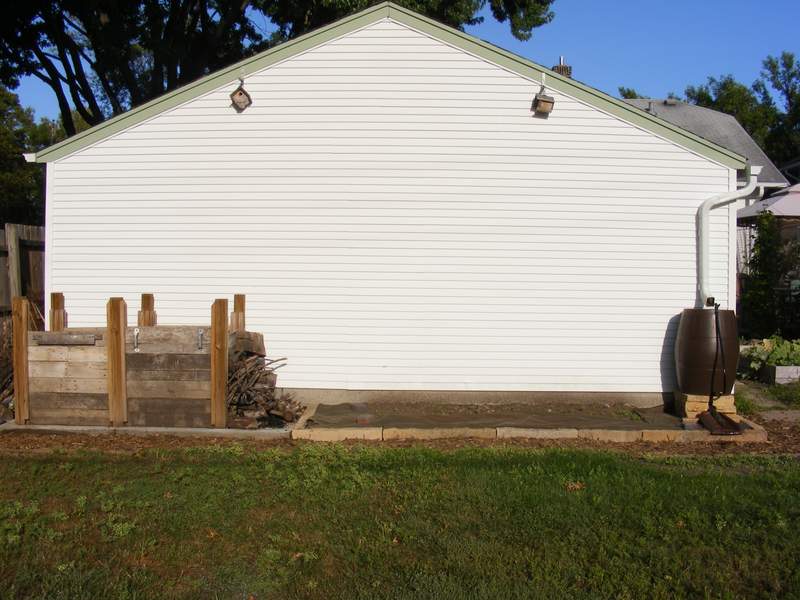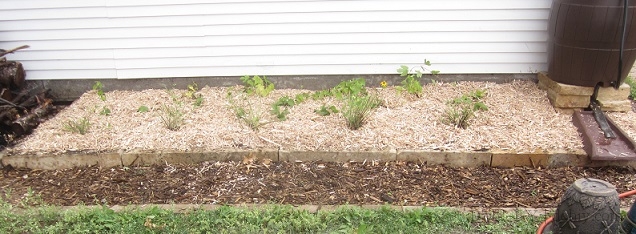What the dilly-o?!
– Marge Simpson
Earlier this year, Ben gave the Kev hops rhizomes, which we’ve been nurturing in pots. We wanted to give them a permanent home in a raised bed behind the garage that didn’t exist at that point. Now that it magically exists, I needed to move the hops in so they could get settled before winter.
Hops are commonly considered vines, but technically, they are bines. Vines attach with tendrils or suckers, but bines simply wind around a support. Instead of needing to spread out to give tendrils or suckers new places to attach, bines can grow straight up.

Hops on a family farm in Wisconsin (via On Milwaukee)
To harvest hops, the line supporting them is detached and laid down for easy picking. Or at least that was the theory when I planned hops for the back of the garage. Support ropes would run from the ground to the roof of the garage, giving the hops a great, full-sun location while breaking up the siding expanse.
I wanted to start with five bine supports running straight up the back of the garage between the rain barrel and the compost bins. Since the lines would be 3-4+ meters tall, I wanted them to be well and truly secured at the bottom (I’ll attach hooks to the garage frame at the top).
I decided to rig the base up out of stuff we had on hand, starting with some old framing timber we removed from the closet wall in the bedroom. The five bines would be about two feet apart — I didn’t have one 10-foot length of wood, but two shorter pieces would do as well. This is tough, old lumber and will last a long time in the ground. I marked the two pieces and drilled five holes where the ropes would attach and two larger holes in each piece for pegs. (Drilling did not go well, but it got done.)
I needed loops through which to thread the ropes, and sticking with the what’s-on-hand model, I used nylon rope. Nylon rope won’t rot under grade, and it’s nice and bright to find in the dirt. I cut lengths of nylon for each loop so that there would be about three inches above the board with a knot under it.
One great advantage of nylon rope is that you can bind it with heat. To make the knots secure, I melted them into undifferentiated masses of goo. I also melted the open ends to prevent raveling.
I couldn’t find our campfire starter for this fiery purpose, so I used matches. I have no Match Fear since my freshman roommate took up smoking (in the hallway, which was a difference without a distinction). She was, however, scared to light a match. In a probably-annoying show of teenage bravado, I repeatedly demonstrated how Not Scary match-lighting was. Now I can light a whole birthday cake full of candles with one match in front of fretting spectators. Having roommates promotes personal growth.
Because I’m a belt-and-braces girl, I ran the loops through galvanized washers and then through their respective holes. (I’ll wait ’til spring to attach the ropes.)
Then, I dug a trench along the garage’s base so that the loops would be just below the raised bed’s surface. Once the boards were in place, I hammered long pegs through the bigger holes to pin the boards in place.
To keep track of the loops, I attached twist ties to poke up, and then I backfilled the trench. Between the weight of the soil and the stakes in the ground, the ropes will be plenty secure.
I enriched the soil with some of our home-made compost and planted the hops, along with some Black-eyed Susan seedlings and catmint divisions. I also scattered Sweet William seeds from our existing patch through the middle of the bed. Then, I watered it all thoroughly.
Once it was good and watered, I topped with wood chip.
It doesn’t look like much right now, but next year, there will be flowers in this bed with the hops stretching high above them. Or at least that’s the plan! (Update: see how the hops did first year, and how our rope choice changed the second year.)











